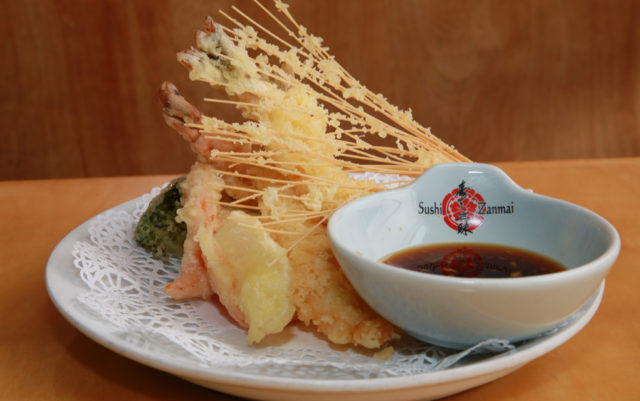
I hadn’t fried anything in years.
I pan sauté ingredients all the time in olive oil, but that’s not the same. It has been drilled into my head over decades that boiling food in oil is dietary kryptonite, banished from the home of any true dieter. (When dining out I admit to being occasionally seduced by the allure of fried falafel, doughnuts and clams.)
Over the holidays, my son and I visited H-Mart to pick up diverse vegetables to make vegetable tempura, something we order at Asian eateries but never attempt at home. I didn’t need to do any research. Deep-frying is like riding a bicycle. I knew how to do it after countless hours cooking tens of thousands of onion rings in Boulder restaurants.
However, when you haven’t done it, deep frying seems complicated and dangerous. It turned out to be pretty easy and inexpensive. You buy a box of tempura mix — there are numerous brands — and combine it with water to make a batter. Cut extra-thin slices or strips of vegetables, coat all over in batter and drop into hot oil. Turn after two minutes and fry until it is done, which is determined by taste-testing.
We considered grapeseed and peanut oils, but settled on a bottle of corn oil. We poured it in a very deep saucepan about an inch deep, which lessens the pain of splattering fat. You need a Goldilocks oil temperature — not so hot that it smokes and not so cool it doesn’t fry. We guessed by sprinkling water in the gradually heating oil until it sizzled. Experts recommend about 375 degrees on a candy/frying thermometer.
Fried vegetables — with or without batter — aren’t necessarily dietary demons. Proper frying adds a minimal amount of fat and preserves fresh vegetable flavors. You can also fry with good fats like coconut versus the undeniably tasty lard and tallow. Frying done wrong results in flaccid, oil-soaked substances.
You remove items from the oil with a slotted spoon and drain on paper towels before eating. We made a dip with soy sauce, toasted sesame oil, vinegar and sriracha. Most of our tempura got eaten standing up in the kitchen.
We used the opportunity to try frying a slew of veggies and almost everything else edible within reach. Some ingredients fared better than others.
Long purple Asian eggplant became exceptionally creamy inside when tempura fried. Eggplant does need to be carefully coated and fried as it is a natural sponge for oil.
Strips of fennel bulb retained their crunch and hint of licorice flavor. Thin pieces of mildly onion-flavored leek — the bottom, not the tough leaves — were perfect. Tempura-dipped bok choy leaves had a bright fresh flavor.
Peeled slices of sweet yellow beet needed to sizzle in the oil twice as long to cook inside. The chips worked better simply fried like potato chips.
For old time’s sake, I fried some yellow onion to make a quasi-onion ring. Yum. Potatoes were best without batter and fried twice: once for about two minutes, set aside, and then fried to crispiness a second time.
Because we had a vat of hot corn oil, the experiment expanded. Tempura hard boiled egg slices tasted exactly like egg croquettes my Mom used to make. Batter-fried pre-crisped bacon was wonderful, as was tempura salmon.
For dessert there were fritter-like Granny Smith apple slices with fried walnut halves.
In a separate pan, we tried frying tempura banana slices in a little leftover smoky bacon fat. It was a fine combo with bottled Indonesian peanut sauce.
Don’t fry too many pieces of tempura at once. It will cool the oil too much to crisp them deliciously. Also, the oil can be strained and reused if you don’t scorch it. Adequate ventilation will prevent your smoke alarm from wailing.
The ultimate wisdom I drew from this family exercise is that deep-frying is damn delicious, very messy and I’d do it again, especially for a gathering.
Most dangerous news: Making doughnuts looks real easy now.
Local food news
The new Shine Restaurant and Potion Bar has opened at 2480 Canyon Blvd. … Chef Alec Shuler’s Arugula Restaurant closes Jan. 13 after nine years in business. His next-door Tangerine will remain open, and a second Tangerine breakfast and lunch spot will start serving in February at 300 S. Public Road in Lafayette. … After many years of limited activity, one of the first local Slow Food chapters in the United States in Boulder is active again. Find out more at: slowfoodboulder.com. … While Top Chef’s season in Colorado continues, look for the poutine burger and Korean BBQ sandwich at Longmont’s Samples World Bistro on this season of Diners, Drive-Ins and Dives on the Food Network. … If you love the hot giardiniera peppers served on Snarf’s sandwiches they are available by the jar at Snarf’s and at Snarfburger locations. … Fungi curious? Denver’s GrowHaus hosts a popular Home Mushroom Growing from Start to Finish Workshop on Jan. 27. thegrowhaus.org. … Finally, a Taco Bell Cantina has opened at 1155 13th St. because The Hill did not have enough Taco Tuesday options. Don’t use the drive-thru window. This Taco Bell doesn’t have one. It also will not serve beer with those beef XXL Grilled Stuft Burritos as planned because it is open too late: 3 a.m.
Words to chew on
“The thing you gotta do is A) Stop counting calories! OK? B) Do not get on a scale! ‘Cause lean muscle weighs more than fat. All right? I cut out FAT! That’s all you gotta do. FAT! No cheese. That’s it, Lisa. Period. NO CHEESE. Skip the butter and skip the cheese and you will lose weight. I swear to God, Lisa.” —Courtney Love
John Lehndorff is a former fry cook at Potter’s Restaurant. He hosts Radio Nibbles at 8:25 a.m. Thursdays on KGNU, 88.5 FM. Podcasts: news.kgnu.org/category/radio-nibbles.














